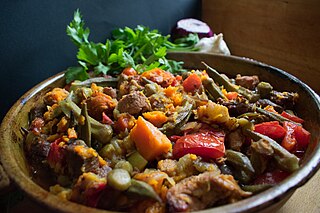
Greek cuisine is the cuisine of Greece and the Greek diaspora. In common with many other cuisines of the Mediterranean, it is founded on the triad of wheat, olive oil, and wine. It uses vegetables, olive oil, grains, fish, and meat, including pork, poultry, veal and beef, lamb, rabbit, and goat. Other important ingredients include pasta, cheeses, lemon juice, herbs, olives, and yogurt. Bread made of wheat is ubiquitous; other grains, notably barley, are also used, especially for paximathia. Common dessert ingredients include nuts, honey, fruits, sesame, and filo pastries. It continues traditions from Ancient Greek and Byzantine cuisine, while incorporating Ottoman, Balkan, and Italian influences.

Turkish cuisine is the cuisine of Turkey and the Turkish diaspora. It is largely the heritage of Ottoman cuisine, which can be described as a fusion of Mediterranean, Balkan, Middle Eastern, Central Asian and Eastern European cuisines. Turkish cuisine has in turn influenced those and other neighbouring cuisines, including those of Southeast Europe (Balkans), Central Europe, and Western Europe. The Ottomans fused various culinary traditions of their realm taking influences from Mesopotamian cuisine, Arab cuisine, Persian cuisine, Armenian cuisine, Greek cuisine, Levantine cuisine, Egyptian cuisine, Balkan cuisine, along with traditional Turkic elements from Central Asia, creating a vast array of specialities. Turkish cuisine also includes dishes invented in the Ottoman palace kitchen.

Kebab, kabob, or kebap or kabab is roasted meat that originates from the Middle East but has been popularised by Iranian cuisine & Turkish cuisine. Many variants of the category are popular around the world, including the skewered shish kebab and the doner kebab with bread.

Phaseolus coccineus, known as runner bean, scarlet runner bean, or multiflora bean, is a plant in the legume family, Fabaceae. Another common name is butter bean, which, however, can also refer to the lima bean, a different species.

Pilaf or pilau is a rice dish, or in some regions, a wheat dish, whose recipe usually involves cooking in stock or broth, adding spices, and other ingredients such as vegetables or meat, and employing some technique for achieving cooked grains that do not adhere to each other.

Moussaka is an eggplant- or potato-based dish, often including ground meat, which is common in the Balkans and the Middle East, with many local and regional variations.

Tabbouleh, also transcribed tabouleh, tabbouli, tabouli, or taboulah, is a Levantine salad made mostly of finely chopped parsley, with tomatoes, mint, onion, soaked uncooked bulgur, and seasoned with olive oil, lemon juice, salt and sweet pepper. Some variations add lettuce, or use semolina instead of bulgur.

Mediterranean cuisine is the food and methods of preparation used by the people of the Mediterranean Basin. The idea of a Mediterranean cuisine originates with the cookery writer Elizabeth David's book, A Book of Mediterranean Food (1950) and was amplified by other writers working in English.

Fasolada or fasoulada is a Greek, Mediterranean, and Cypriot soup of dry white beans, olive oil, and vegetables. It is sometimes called the "national food of the Greeks".

Iraqi cuisine is a Middle Eastern cuisine that has its origins in the ancient Near East culture of the fertile crescent. Tablets found in ancient ruins in Iraq show recipes prepared in the temples during religious festivals—the first cookbooks in the world. Ancient Mesopotamia was home to a sophisticated and highly advanced civilization, in all fields of knowledge, including the culinary arts.

Lebanese cuisine is the culinary traditions and practices originating from Lebanon. It includes an abundance of whole grains, fruits, vegetables, fresh fish and seafood. Poultry is eaten more often than red meat, and when red meat is eaten, it is usually lamb and goat meat. Dishes include copious amounts of garlic and olive oil, and dishes are often seasoned with lemon juice. Chickpeas and parsley are also staples of the Lebanese diet.

Ottoman cuisine is the cuisine of the Ottoman Empire and its continuation in the cuisines of Turkey, the Balkans, Caucasus, Middle East and Northern Africa.

Yakhni, yahni (Turkish), or yahniya is a class of dishes traditionally prepared in a vast area encompassing South Asia, the Middle East and Southeast Europe or the Balkans.

Gigantes plaki or Greek giant baked beans, is a Greek dish of large white beans baked in a tomato sauce. Gigantes plaki may be served as a main dish or as a meze. The beans are traditionally fasolia gigantes 'giant beans', a variety of the Phaseolus coccineus.

Rājmā, also known as rajmah, rāzmā, or lal lobia, is a vegetarian dish, originating from the Indian subcontinent, consisting of red kidney beans in a thick gravy with many Indian whole spices, and is usually served with rice. It is a part of the regular diet in Northern India, Nepal and Punjab province of Pakistan. The dish developed after the red kidney bean was brought to the Indian subcontinent from Mexico. Rajma Chawal is kidney beans served with boiled rice.
Ladera, zeytinyağlı (yemekler) (Turkish), or bil zayt is a category of vegetable dishes cooked in olive oil in Greek, Turkish, and Arabic cuisines. The name in all these languages means "with (olive) oil".

Türlü is a casserole of Turkish cuisine. It is made of stewed vegetables and may also include stewed meat. Varieties of this dish are also found in Balkan cuisines. In particular, it is known as turli perimesh in Albania, tourlou or tourlou tourlou in Greece, and as turli tava in North Macedonia.

















